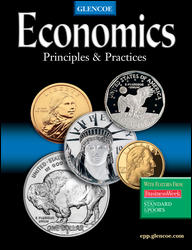
Economics Principles & PracticesChapter 15: The Fed and Monetary PolicyChapter OverviewsChapter 15 examines the Federal Reserve System, monetary policy, the impact of monetary policy on the economy, and some policy issues such as the timing and burden of monetary policy. Section 1 describes the role of the Fed as primary regulator of all state-chartered member banks and commercial banks. The structure of the Fed is that of a corporation whose stock is owned by its member banks. It consists of a Board of Governors, the Federal Open Market Committee, a Federal Advisory Council, and several other advisory committees. The Fed also has broad authority over bank operations in a number of different areas including international banking and member bank mergers. Other services provided by the Fed include check clearing, enforcing consumer legislation, maintaining the quality of currency and coins in circulation, and providing financial services to the government. Section 2 explains how modern commercial banking operates on a fractional reserve system. Monetary policy affects the size of the money supply, and therefore the level of interest rates, by making use of the fractional reserve system. The first "tool" of monetary policy—and the one used least often—is a change in the reserve requirement. The second, and most popular and powerful, tool of monetary policy is open market operations. A change in the discount rate is the third major tool. The Fed also has several selective credit controls such as margin requirements. Section 3 describes the Fed's trade-off between lower interest rates today and more inflation later on, along with issues relating to the timing and burden of monetary policy. Because the interest rate is the price of credit, it is one of the most visible and politically sensitive prices in the economy. For this reason, interest rates are closely watched. |  |















